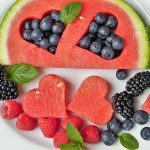What are the indicators that we are achieving our dietary goals for nutrients each day? Figuring out the nutritional content of what you eat and drink without professional help can be an inexact process. Acceptable health standards have been established regarding nutrient intake as continued under-consumption could eventually result in medical issues.
The amount of food suggested to be eaten each day to satisfy the nutritional needs of almost all healthy people in a certain stage of life and gender is called Recommended Dietary Intake (RDI).
The Adequate Intake or AI is the amount of daily intake of a nutrient that is considered to be adequate, based on what has been seen in healthy individuals or as determined by experiments. AI is employed in circumstances where insufficient data is present to ascertain an RDI.
An SDT is a proposed average daily level of nutrients from food and drinks, meant to thwart chronic sickness. Limitations have been established for only a few nutrients, such as sodium, fiber, and vitamin C.
The greatest amount of a certain nutrient that can be consumed on a daily basis without causing any harm to most people is called the upper limit. As consumption rises above the highest recommended amount, the chance of unwanted effects rises. Remember, more is not always better.
Calcium
Not getting enough calcium can cause bone deformities in young ones and fragile bones and weakening bones in later life. It is very important for the health of the heart, the movement of muscles, and the formation of blood clots.
It is vital that if you opt for non-dairy items, they have been fortified with calcium, since dairy products are essential sources. Soybeans, tofu, and certain nuts, particularly almonds, as well as green vegetables, including broccoli and cabbage, contain calcium; however, it is not taken in as quickly as calcium from dairy products.
Expectant mothers assimilate calcium more productively in order to fulfill the requirements of the unborn child.
RDI: Children from the age of nine to thirteen should be consuming between 1,000 and 1,300mg of the substance, while teenagers from 14 to 18 should consume 1,300mg. Women who are between 19 and 50 as well as males aged 19-70 should take in 1,000mg, and finally women older than 50 and men over seventy should consume 1,300mg.
Purium’s Calcium Product: Super Meal LOV
Vitamin C
In order to have strong teeth, bones, and tendons and clear skin, Vitamin C is essential for creating collagen. This substance possesses strong antioxidant properties that help guard cells and increase resistance to illness.
Vitamin C is primarily found in vegetables and fruit, with only miniscule amounts in other food items. No definitive maximum exists, however exceeding 1000mg in one day could produce intestinal difficulties.
RDI: 9–13 years 45 mg 14–18 years 75 mg 19+ years 90 mg Individuals who smoke require 35 mg/day more vitamin C than nonsmokers.
Purium’s Vitamin C Products:
Iron
Iron is necessary in order to construct hemoglobin, a protein which carries oxygen from the lungs to each cell throughout the body. If there is an insufficient amount of iron, there is a low availability of oxygen with a high likelihood of exhaustion and an inability to focus. Iron deficiency is very common. Many people need to take supplements of iron to keep the right level of iron in their bodies. Iron deficiencies occur when there is an excessive loss of iron or there is too little iron in the diet.
Your body’s defense system against disease can be weakened, making it more likely for you to become ill. A physician must identify and treat iron deficiency anemia.
Animal-derived iron is more simply absorbed by the body than iron originating from plants. Lean cuts of beef and mussels are excellent sources of heme iron.
Non-haem iron can be obtained from various sources, such as baked beans, lentils, broccoli, kale, watercress, whole grain breads, and fortified breakfast cereals.
It is not recommended to have tea, coffee, and dairy items together, as these types of foods impede digestion. Vitamin C aids in the uptake of non-hemoglobin iron, as well as overcoming obstacles which may prevent iron from being absorbed. Six mussels contain more iron than a lean steak.
RDI: For children between 9 and 13, 8 milligrams for girls and boys; 14 to 18 year olds should receive 15 milligrams for girls and 11 milligrams for boys; women aged 19 to 50 should have 18 milligrams and both women and men aged over 50 should have 8 milligrams.
Purium Products that Contain Iron:
Selenium
Selenium generates crucial enzymes that prohibit cells and tissue from damage by oxidation. This also assists with procreation, strengthening the body’s resistance to infection and improving cognitive capabilities. Brazil nuts are easily the most abundant provider of selenium; however, it can also be found in various other food items such as fish, eggs, various other kinds of seafood, meat and cashew nuts.
RDI: Children between the ages of 9 and 13 should take 50mcg, while females aged 14 and over should take 60mcg and males aged 14 and over should take 70mcg.
Purium Products that Contain Selenium: Power Shake and Super Meal LOV
Iodine
It may cause thyroid problems, which affect metabolism. Since the requirement of including iodine in all loaves of bread in 2009, the levels of iodine among individuals aged 15 and over have increased significantly, thus reaching an ‘adequate’ amount. But Kiwi women over 30 still don’t get enough.
Iodine plays a major role in the creation of thyroid hormones, which are responsible for regulating how quickly energy (kilojoules) is used and the chemical processes in our bodies.
In order to prevent goiter, a condition in which the thyroid gland enlarges while trying to create thyroxine and metabolism slows, a minimum of 40mcg of intake daily is necessary.
The top two sources of omega-3 fatty acids are fish and shellfish, however, these fatty acids can also be found in milk and bread. Ingesting an excessive amount of iodine can result in alterations to thyroid functioning in the future and may bring about weight increase. Consult with your doctor or a nutritionist before taking any type of supplement.
Recommended Dietary Allowances (RDAs) for Iodine
- Birth to 6 months 110 mcg 110 mcg
- 7–12 months 130 mcg 130 mcg
- 1–3 years 90 mcg 90 mcg
- 4–8 years 90 mcg 90 mcg
- 9–13 years 120 mcg 120 mcg
- 14–18 years 150 mcg 150 mcg
- 19+ years 150 mcg 150 mcg
Purium Products that Contain Iodine:
Fiber
Fiber is essential for our digestive system to run properly and is linked with a decreased risk for numerous illnesses, such as bowel cancer, type 2 diabetes and heart disease. It is essential to have an adequate amount of liquids throughout the day so that the dietary fiber can generate soft feces in your colon.
Whole grains, such as breakfast cereals, bread, pasta, and rice, along with vegetables, fruit, nuts, and seeds all supply fiber. You should progressively raise your fiber consumption and drink lots of fluids or it might result in stomach gas and abdominal distention.
Easy ways to boost fiber: One cup of boiled broccoli contains 5.6 grams; half a cup of raw whole wheat spirals or penne pasta has 5.3 grams; two slices of grainy toast have between 4.5 and 6 grams; one apple holds 3.5 grams; two teaspoons of chia seeds give 3 grams; and a 30 gram serving of mixed nuts has 2.3 grams.
READ MORE: 17 Ways To Get Fiber In Your Diet
RDI: Total dietary fiber intake should be 25 to 30 grams a day from food.
Purium Products that Support Fiber: Daily Fiber
Potassium
It is necessary to have potassium in order for us to keep our bodily fluids balanced and for our heart’s electrical signals to perform as they should. All types of food such as vegetables, fruit, nuts, seeds, fish, shellfish, beef, and chicken can be included in one’s diet.
The greater the amount of potassium you consume (up to a certain amount), the more sodium your body will release through urination. Potassium can help to reduce rigidity in the walls of the blood vessels. The synergy of these two effects can result in a beneficial outcome for blood pressure.
RDI:
| Age | Male | Female | Pregnancy | Lactation |
|---|---|---|---|---|
| Birth to 6 months | 400 mg | 400 mg | ||
| 7–12 months | 860 mg | 860 mg | ||
| 1–3 years | 2,000 mg | 2,000 mg | ||
| 4–8 years | 2,300 mg | 2,300 mg | ||
| 9–13 years | 2,500 mg | 2,300 mg | ||
| 14–18 years | 3,000 mg | 2,300 mg | 2,600 mg | 2,500 mg |
| 19–50 years | 3,400 mg | 2,600 mg | 2,900 mg | 2,800 mg |
| 51+ years | 3,400 mg |
Purium Products that Contain Potassium: Power Shake
Zinc
Nourishing the body with the right nutrients is critical for maintaining flawless skin, strengthening the immune system, and speeding up the healing process of wounds. This assists in digesting and utilizing proteins, fats, and carbohydrates. Include lean cuts of red meat, shellfish, some types of nuts and seeds, and wheatgerm that is often found in types of bread and breakfast cereals.
Excess zinc intake (up to 40 mg a day for grown-ups) can have an opposite effect from what is desired and impair your immunity. Nonetheless, it is still essential to get the right amount of zinc to ensure a strong immune system.
RDI: Table 1: Recommended Dietary Allowances (RDAs) for Zinc [1]
| Age | Male | Female | Pregnancy | Lactation |
|---|---|---|---|---|
| Birth to 6 months* | 2 mg | 2 mg | ||
| 7–12 months | 3 mg | 3 mg | ||
| 1–3 years | 3 mg | 3 mg | ||
| 4–8 years | 5 mg | 5 mg | ||
| 9–13 years | 8 mg | 8 mg | ||
| 14–18 years | 11 mg | 9 mg | 12 mg | 13 mg |
| 19+ years | 11 mg | 8 mg |
Purium Products That Contain Zinc:
Different Ways To Hit Your Daily Nutrition Goals
1. Food Prep And Planning Ahead
Without a strategy and regular meal preparation ahead of time, it will be much more difficult to reach your dietary aspirations. Preparing beforehand simplifies having meals and treats that are speedy, delicious, and in line with your objectives.
A study of a behavior-focused weight loss plan showed this effectively. Frequent meal planning by participants was shown to be associated with greater weight loss during the program.
The last thing anyone desires is to be confined to home, work, or on the road and be unable to consume the nourishment that their body necessitates. Depending on fast food and takeaways sets us up for a crash since they may not have something on hand that abides by your rules.
When you’re eating while famished, it’s easy to go overboard and indulge on higher calorie food choices than you should, as your palate is likely to be more assertive than your stomach. To ensure that you stay on track, spend a few hours each week planning out your meals by:
- Grocery shopping and stocking your fridge with healthy groceries
- Prepping, washing, and chopping your produce so they’re ready to use
- Cooking, and storing the produce, proteins, and starches that will then become elements to your meals that you can assemble in minutes
When you cook ahead of time, you will have a full refrigerator of prepared staple foods such as pre-cooked proteins and carbohydrates, pre-cut vegetables for salads, boiled eggs, chopped fruits and so on.
2. Make Sure To Prioritize Micronutrients
No matter what your objective is with regards to your physical makeup, your body requires more than just energy and macro-nutrients to stay healthy. It is necessary to take in an adequate amount of micronutrients to dodge deficiencies and ensure that the body’s organs and systems work to their peak capacity. A landmark study which analyzed nutrient levels between 1950 and 1999 has revealed that a decrease in micronutrients can be observed in many types of food.
Massive agricultural production strips the ground of numerous trace nutrients.
It is strongly recommended that a supplement containing high amounts of magnesium is included in one’s daily routine because of its essential role in more than 300 biochemical processes occurring in the body. More than 80% of the population is unable to fulfill their nutrient needs solely from food sources.
3. Use Your Hands To Measure Portions
If your objective is to slim down or build muscle, then controlling your calorie intake is important. This means you have to monitor your portion sizes.
Thankfully, you have an inborn system for figuring out the exact amounts suitable for you. What combination and quantities of food are needed in order to create a meal plan that meets your needs? It is up to us to use our hands as a way of evaluating the portions we are eating so that we do not eat more or less than we need to. Across each meal you can use this system as a baseline:
- 1-2 palms of protein
- 1-2 cupped handfuls of carbs (fruit or starches)
- 1-2 fists of vegetables
- And 1-2 thumbs worth of fat.
4. Utilize High Quality Shakes For Easy, Quick, And Satisfying Meals
Protein intake is very important if you’re:
- Training multiple days per week
- Building muscle mass
- Improving your mood and cognitive function
- Losing body fat on a caloric deficit and wanting to keep your muscle mass
- Working to stabilize your blood sugar and minimize craving
A lot of individuals have a hard time getting enough protein, so making a point of incorporating a good quality protein powder into one’s diet can be beneficial for keeping muscle mass and promoting faster recuperation.
It is suggested that the average amount of protein a person needs to stay healthy is 0.8g/kg of bodyweight per day. However, evidence shows that 1.2 – 1.6g/kg is likely the best amount of protein to consume.
If you weigh 160 lbs (72.5 kg), you should be consuming between 87 and 116 grams of protein each day, or an even greater amount if you’re participating in strenuous exercise. Plant-based eaters who don’t want to rely heavily on beans and rice may find protein powder to be a very useful and convenient resource. If you’re limiting calories and eating plant-based foods, it will be easier to reach your goals if you focus on foods that are rich in protein. These foods tend to have higher levels of carbs or fats than other foods.
Additionally, there is no longer any justification as you can easily put a couple of ingredients in the blender, blend, and be on your way.
Mix your powders with water, coconut water, or even a scoop of greens, and grab a cup to take it with you wherever you go. You will be able to access excellent liquid meal replacements at any time.
5. Eat Fresh, Organic, And Wild As Much As Possible
Previously we discussed how farms can cause the depletion of vital nutrients in the soil, which in turn affects the food produced on them. You should focus on eating food that is as natural, unprocessed, and recently harvested as possible. This can have a significant impact on achieving the highest level of nutrition while still maintaining the same number of calories and not requiring extra cost. There are scores of edible plants in the wild that you can acquire without cost.
Eating produce that is grown locally, or in your own home, is usually more beneficial when eaten shortly after it is picked since it tends to contain more nutrients and be more fresh. The chefs of renown are always right; fresh ingredients yield the most tasty and enjoyable food. If you would like to try your hand at taking wild edibles, the best way to get started is to look for a nearby foraging class and then venture outside with an experienced forager to assist with recognizing the safe, edible plants.









